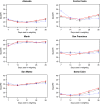COVIDNearTerm: A simple method to forecast COVID-19 hospitalizations
- PMID: 35720970
- PMCID: PMC9161046
- DOI: 10.1017/cts.2022.389
COVIDNearTerm: A simple method to forecast COVID-19 hospitalizations
Abstract
Introduction: COVID-19 has caused tremendous death and suffering since it first emerged in 2019. Soon after its emergence, models were developed to help predict the course of various disease metrics, and these models have been relied upon to help guide public health policy.
Methods: Here we present a method called COVIDNearTerm to "forecast" hospitalizations in the short term, two to four weeks from the time of prediction. COVIDNearTerm is based on an autoregressive model and utilizes a parametric bootstrap approach to make predictions. It is easy to use as it requires only previous hospitalization data, and there is an open-source R package that implements the algorithm. We evaluated COVIDNearTerm on San Francisco Bay Area hospitalizations and compared it to models from the California COVID Assessment Tool (CalCAT).
Results: We found that COVIDNearTerm predictions were more accurate than the CalCAT ensemble predictions for all comparisons and any CalCAT component for a majority of comparisons. For instance, at the county level our 14-day hospitalization median absolute percentage errors ranged from 16 to 36%. For those same comparisons, the CalCAT ensemble errors were between 30 and 59%.
Conclusion: COVIDNearTerm is a simple and useful tool for predicting near-term COVID-19 hospitalizations.
Keywords: COVID-19; SARS-CoV-2; forecasting; hospitalization; prediction.
© The Author(s) 2022.
Conflict of interest statement
We have no conflicts of interest to disclose.
Figures




References
-
- Roy S, Economic impact of Covid-19 pandemic. A Preprint 2020, 1-29.
Grants and funding
LinkOut - more resources
Full Text Sources
Miscellaneous
